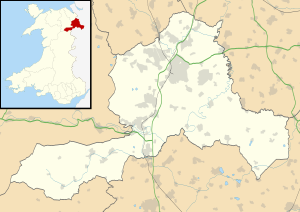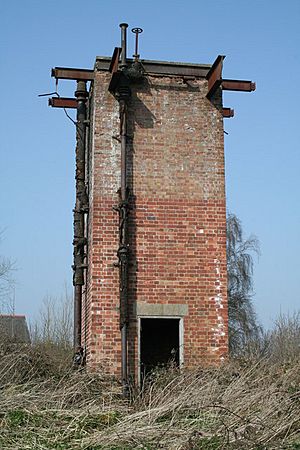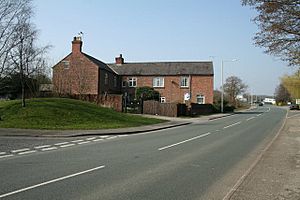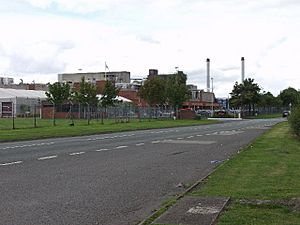Wrexham Industrial Estate facts for kids

Redwither Tower, largest office building on the estate
|
|
| Location | Wrexham, Wales |
|---|---|
| Coordinates | 53°02′20″N 2°55′37″W / 53.039°N 2.927°W |
| Owner | Welsh Government |
| No. of tenants | 300 |
| No. of workers | 10,000 |
| Size | 550 hectares |
The Wrexham Industrial Estate (in Welsh: Ystâd Ddiwydiannol Wrecsam) is a very important business area in Wrexham, Wales. It is located on the eastern edge of the city, about 3 miles from the city center.
This huge area was once a factory that made weapons during World War II. It was first called the Wrexham Trading Estate. Today, it covers about 550 hectares (which is about 1,360 acres). It is the biggest industrial estate in Wales and one of the largest in Europe!
Around 300 different businesses are located here. They provide jobs for about 10,000 people. The estate has many types of workplaces, from single factories to large business parks. It is also home to HM Prison Berwyn, which is the UK's largest prison.
Contents
A Secret Factory: ROF Wrexham
The Wrexham Industrial Estate started as a secret factory during World War II. It was called Royal Ordnance Factory (ROF) Wrexham. This factory made cordite, which is an explosive material used to power shells and bullets.
About 13,000 people worked here during the war. The location was chosen carefully. It was far enough from German bomber bases in Europe to be safe. It also had good train connections and a rural area with many workers.
The factory was spread out over a large area. This helped to reduce damage if it was attacked from the air. The main buildings were hidden with camouflage. Old farm buildings were even left in place to make the factory harder to spot. Many of these original buildings are still used by smaller businesses today. You can tell them apart by the large grids near their roofs. These grids were important for ventilation because of the chemicals used inside.
To get water for the factory, a special plant was built on the River Dee. This plant supplied all the water needed for making cordite.
The factory also had a large train yard with 10 different tracks. These tracks connected to the factory's own rail system. All the cordite made here was sent by train to other places. Diesel engines were used for moving trains around the factory. This was safer than steam engines, as they were less likely to cause a spark and ignite the cordite.
The factory was well protected from attacks. There were several concrete bunkers, called pillboxes, around the area. These can still be seen today in places that haven't been built on. The factory was also close to RAF Wrexham, an air force base. This base had fighter planes ready to defend the area from enemy bombers.
After the war ended in 1945, the factory stopped making cordite. Many of the buildings were left empty. The land around them slowly returned to farmland.
Growing After the War
Even though the factory closed, its many empty buildings attracted new businesses. In the 1950s, a large company called British Celanese opened a factory here. They made acetate yarn, a type of fiber.
Other big companies also came to Wrexham later on. These included Firestone, Kellogg's, and JCB.
The Welsh Development Agency officially made the area an industrial estate. They helped businesses move there. This was done to create stable jobs and help Wrexham recover from tough economic times in the 1960s and 1970s.
By 1990, the British Celanese factory was sold to another company called Courtaulds. Eventually, the last building they owned, Redwither Tower, was sold to Wrexham Council. The council reopened Redwither Tower as a business park. Many offices are now located there.
Wrexham Industrial Estate Today
Today, the Wrexham Industrial Estate is a busy place. It covers about 550 hectares. More than 300 businesses operate here, employing over 7,000 people.
Some well-known companies on the estate include:
- Kellogg's: This factory makes many of their popular cereals, like All-Bran, Bran Flakes, and Special K.
- JCB: A famous company that makes construction equipment.
- Jones' Village Bakery: This local company has two bakeries on the estate.
- Other companies like Wockhardt, Cytec Engineered Materials, Hoya Lens, Ball Packaging Europe, and Calypso Soft Drinks also have sites here.
Getting Around
Because the estate is a bit separate from Wrexham city, it helps keep the city center free from heavy industrial traffic. However, getting to and from the estate used to be a problem. New access roads were built to make it easier for cars and trucks. A £30 million road project opened in 2012, greatly improving access.
HM Prison Berwyn
In 2013, it was announced that a new prison would be built on the estate. This prison, HM Prison Berwyn, opened in 2017. It is designed to hold over 2,100 prisoners, making it the largest prison in the UK.
Nature Projects
Since 2014, the North Wales Wildlife Trust has been working on a special project called "Wrexham Industrial Estate Living Landscape." They work with businesses and local people to make the estate greener and better for wildlife.
The project aims to:
- Help nature and businesses grow together.
- Create more places for wildlife to live.
- Improve the health and happiness of workers and visitors.
One of the things they do is plant colorful native wildflowers along roads and roundabouts. This helps make the area beautiful and provides food for insects. The estate is home to some rare species, like the grizzled skipper butterfly, the great crested newt, and the bee orchid. There's even a tiny beetle called Pseudorchestes pratensis that has only been found in two places in Wales, and one of them is here!





